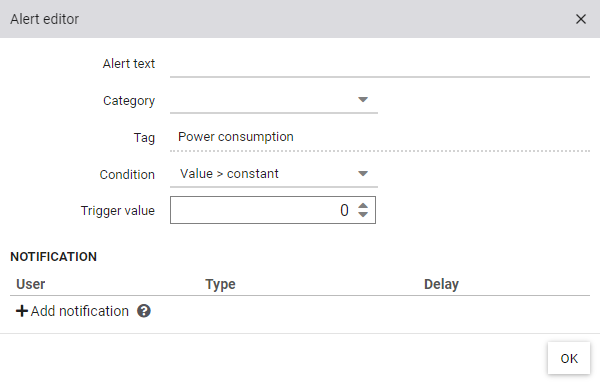Alerts
Alerts are used to monitor tags. When a configured condition arises, an alert message is generated, which is displayed in the alert list. As soon as the condition is no longer met, the alert event is ended and the message is only visible in the alert log. The monitoring of tags is also known as condition monitoring.
Configure alert
The configuration of an alert is done at the tag. In the tree, navigate to the desired tag, open the context menu and select Add alert.

The following properties can be defined on an alert:
| Alert text |
Text describing the alert. Note: This text appears during notifications or is read aloud during voice calls. |
| Category |
Optional: Free text for categorization. The drop-down list contains all previously entered categories so that they can be quickly reused. |
| Condition | Selection of conditions as well as one or more parameters. See the following description of triggers. |
| Trigger after | In some cases, alerts are only relevant if the condition is fulfilled for a longer period of time. Examples of this are brief interruptions in communication or setpoint deviations of short duration. The alert is only triggered when the condition is continuously fulfilled for the specified time (in seconds, minutes or hours). This means that no entry is made in the alert log if the specified time has not been reached. However, use the delayed notification if you want the alert to be logged immediately but the notification to be delayed. |
Triggers
Depending on the data type, different conditions can be configured.
| Value / Constant Comparison | Alert is triggered when the value of the tag is greater than, less than, not equal to, or outside of fixed defined limits. The constant or min/max are fixed in the alert configuration. |
| Value / Variable comparison | The value of the tag is compared with the value of another tag (e.g. a setpoint or a dynamic limit value). The comparison variable can be specified via drag & drop. |
| Hysteresis |
A hysteresis can be used to prevent flickering, i.e. the constant triggering and resetting of an alert when the value fluctuates around the trigger value.
If the trigger value is greater than the reset value, the alert becomes active when the trigger value is exceeded.
If the alert is to be triggered when the value falls below, the reset value must be greater than the trigger value. Example: To monitor a boiler temperature, the trigger value is set to 90°C. 80°C is specified as the reset value. Thus, the alert becomes active as soon as 90°C is exceeded. The alert is reset once the temperature falls below 80°C. |
| Bit high / low |
By evaluating individual bits, up to 32 states can be monitored with just one tag. Example: The value 4 is 0100 in binary form. Here the third bit is high, all others low. |
| Value increased / decreased | Trigger alert on rising or falling value. |
| Value out of scale |
If in tag settings min/max have been specified for the scaling or a linear conversion,
an alert can be triggered as soon as the value gets outside the configured scaling. Example: With a 4-20mA signal, an alert can be triggered when the current falls below 4mA. |
| Value invalid (infinity/NaN) | Only for floating point numbers: Alert when the value becomes imaginary, i.e. NaN (Not-a-Number) or infinite. |
| Counter value ungültig | For counter tags only: alert, when counter reading is decreasing. |
| Aggregated value / threshold profile | Alerting after aggregation of historical values with optional threshold profile. For more details, see aggregated value analysis. |
| Trend: mean value / slope | Alerting after determination of the mean value or the slope. For more details, see trend analysis. |
| Logical tags | |
| Value true / false |
Alert is triggered when the value becomes TRUE or when the value becomes FALSE.
|
| String tags | |
| Value is not empty | Alert is triggered when the value is not empty. The text that led to the triggering is stored in the alert. The alert is reset by an empty value. |
| Common conditions | |
| No value change | Alert is triggered when the value does not change for a specified period of time. |
| Data exchange disturbed | If the cloud adapter is connected but the value of the tag cannot be read, an alert is triggered. This is usually the case if the target device does not respond as expected or has failed. An alert is also triggered if the symbol is no longer available or if a formula becomes invalid. |
Automatic alert recycling
To prevent a flood of alerts, AnyViz uses alert recycling: If an alert is reset and triggered again within 10 seconds, no new alert will be created. Instead, the recently reset alert instance is reactivated.
This has the effect that no new notification is sent.